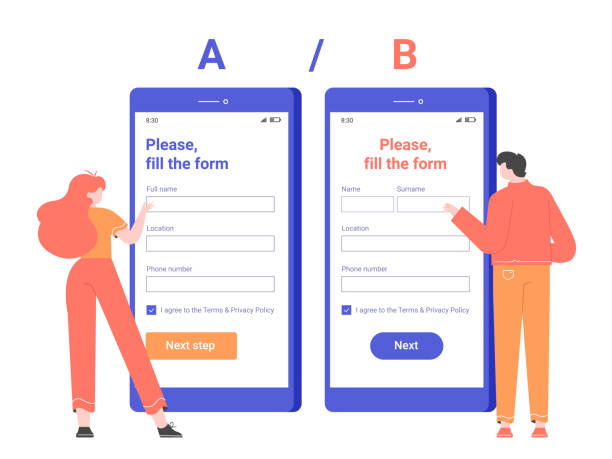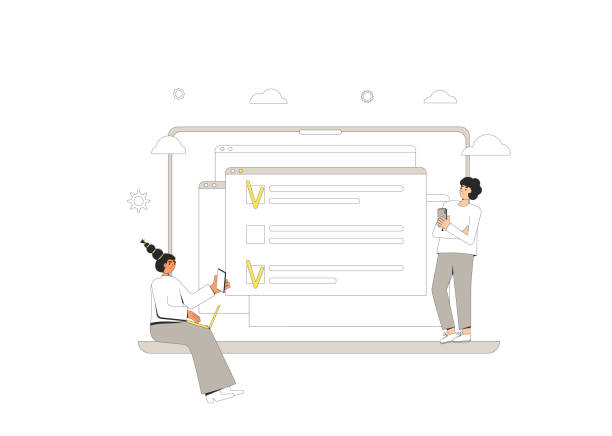Introduction to Secure Website Design and Its Importance

In today’s digital world, secure website design is no longer an option, but a vital necessity.
With the increasing cyber threats, every website, whether small or large, is at risk of attacks.
#Website_Security, #Data_Protection, #Cybersecurity, and #Attack_Prevention are among the key concepts in this field.
If your website processes or stores sensitive information such as personal user data, financial information, or even proprietary content, securing the website is of double importance.
The main goal of this explanatory and educational section is to familiarize you with the necessity of this topic and the irreversible consequences of ignoring it.
Successful attacks can lead to loss of customer trust, heavy legal penalties, damage to brand reputation, and even business failure.
Imagine if your customers’ banking information is stolen or your website experiences widespread disruptions; the consequences of such events can be catastrophic.
Therefore, for every web developer and online business owner, a deep understanding of the fundamentals of cybersecurity and its proper implementation, from the initial design phase, is an undeniable requirement.
This article will help you become familiar with the principles and techniques of secure website design and protect your website against threats.
Are you losing potential customers due to an unprofessional website? Rasaweb is your answer! With our specialized corporate website design services:
✅ Enhance your business’s credibility and standing
✅ Experience attracting more targeted customers
⚡ Act now to receive a free consultation!
Common Web Security Threats and How to Identify Them

Understanding the threats your website may face is the first step in secure website design.
This section specializedly and analytically addresses the most common cyber attacks.
One of the most well-known attacks is SQL Injection, where attackers inject malicious code into website inputs to gain access to the database and steal or alter sensitive information.
Another prevalent attack is Cross-Site Scripting (XSS), where malicious JavaScript code is injected into legitimate web pages and can lead to the theft of cookies or user information.
Cross-Site Request Forgery (CSRF) attacks are also significant threats, in which an attacker tricks a user into sending malicious requests to a website without their knowledge.
Denial of Service (DoS) and Distributed Denial of Service (DDoS) attacks render a website’s server inoperable by sending a huge volume of fake traffic.
Furthermore, Brute-Force Attacks to discover weak passwords, and software vulnerabilities in outdated frameworks and plugins constantly threaten websites.
Understanding these vulnerabilities and knowing how to detect them is the foundation of website security and helps you design and implement effective defenses against these threats.
DDoS attacks are just one of the tools attackers use to disrupt service.
Basic Principles in Secure Website Design from the Outset

To achieve secure website design, fundamental security principles must be considered from the very early stages of development.
This educational and guidance approach is far more effective and cost-efficient than trying to add security after project completion.
One of the most important principles is the “Principle of Least Privilege”; meaning that every user, process, or service should only have access to the minimum resources necessary to perform its functions.
Strict Input Validation is another vital principle; all data entered by users must be carefully checked and sanitized to prevent malicious code injection.
Also, the use of Prepared Statements in database queries to prevent SQL Injection, and the encryption of sensitive data, both in transit and at rest, are essential measures.
Regularly updating software, frameworks, and libraries to the latest secure versions is also crucial, as older versions often have known vulnerabilities.
Proper error handling and logging are also an important part of website security.
Logs should provide enough detail to detect attacks but should not include sensitive information.
Finally, training the development team in the best practices of web application security is also a fundamental principle.
To further enhance security, configuring HTTP security headers is also recommended.
The table below lists some important security headers and their uses:
| Security Header | Purpose |
|---|---|
| Content-Security-Policy (CSP) | Protection against XSS and data injection attacks by controlling authorized resources for loading |
| X-Content-Type-Options | Prevention of Mime-Type Sniffing attacks by ensuring resources are loaded with the correct content type |
| X-Frame-Options | Protection against Clickjacking attacks by controlling page display in iframe tags |
| Strict-Transport-Security (HSTS) | Enforcing HTTPS for all future connections to the website |
| Referrer-Policy | Controlling the amount of Referrer information sent when the user navigates to other websites |
The Role of HTTPS and SSL/TLS Security Protocols in Website Security

Secure website design is almost meaningless without the use of HTTPS protocol.
This section specializedly and explanatorily addresses the importance of HTTPS and its underlying technologies, namely SSL/TLS.
HTTPS (Hypertext Transfer Protocol Secure) is the secure version of HTTP that establishes a secure connection between the user’s browser and the website server by encrypting data.
This encryption is performed by SSL/TLS (Secure Sockets Layer/Transport Layer Security) certificates.
When a user enters information such as username, password, or credit card details, HTTPS ensures that this information is protected from eavesdropping and tampering by third parties (Man-in-the-Middle attacks) during transmission.
An SSL/TLS certificate is a digital file that verifies the identity of a website and enables encrypted communication.
Installing this certificate on the website server indicates your commitment to website security and provides assurance to users.
Browsers mark websites without HTTPS as insecure, and this not only negatively impacts user trust but can also lower your website’s SEO ranking.
Google prioritizes websites with HTTPS.
For a secure website, ensuring that the SSL/TLS certificate is valid and up-to-date is crucial.
Also, implementing HSTS (HTTP Strict Transport Security) is recommended so that browsers always load your website via HTTPS and prevent any attempts at insecure communication.
These protocols form the backbone of any modern secure website design and ensure the protection of user privacy and data security.
Is your current corporate website presenting a worthy image of your brand and attracting new customers?
If not, turn this challenge into an opportunity with Rasaweb’s professional corporate website design services.
✅ Significantly improves your brand’s credibility and image.
✅ Paves the way for attracting leads and new customers for you.
⚡ For free and specialized consultation, contact Rasaweb now!
Password Management and Strong User Authentication

One of the common vulnerabilities in secure website design is weakness in password management and authentication systems.
This section guides and educates on methods you can employ to strengthen this aspect of your website’s security.
The first step is to compel users to use strong and unique passwords.
These passwords should be a combination of uppercase and lowercase letters, numbers, and symbols, and have a specified minimum length.
Also, direct storage of passwords in the database should be avoided; instead, strong hashing techniques like bcrypt or Argon2 should be used, so that even if the database is breached, user passwords cannot be recovered.
Salt (adding a random string to the password before hashing) is also essential to prevent Rainbow Table attacks.
Two-Factor Authentication (2FA) is one of the most effective methods for increasing the security of user accounts.
With 2FA, even if a user’s password is stolen, the attacker needs an additional verification code (usually via an app, SMS, or email) to log into the account.
This feature should be implemented as a standard option in your secure website design.
Furthermore, implementing an account lockout mechanism after multiple failed login attempts and Captcha to prevent Brute-Force attacks is essential.
Educating users about the importance of strong passwords and how to use their accounts securely is also an important part of the website protection strategy.
The “forgot password” feature should be used securely, and sending the password directly to the user’s email should be avoided; instead, a password reset link should be sent.
These collective measures provide stronger security layers for users and, consequently, for your entire secure website.
Database Security and Protection of Sensitive Information

The database is the heart of any website and contains the most valuable information; therefore, secure website design is incomplete without special attention to database security.
This section specializedly and explanatorily discusses strategies for protecting data in the database.
The first step is to use user accounts with the least privilege to connect to the database; meaning your web application should not connect to the database with a root account or with all privileges.
Each user or service should only have access to the tables and operations they need.
Encrypting sensitive data in the database, such as credit card information or national identification numbers, even at rest encryption, provides an additional layer of security.
This makes it difficult for an attacker to read the information, even if the database is breached.
Input Validation and the use of Prepared Statements to prevent SQL Injection attacks, as mentioned earlier, are of vital importance.
These measures ensure that malicious codes cannot harm the database.
Also, regular and secure backups of the database are essential.
These backups should be stored in a separate and secure location so that recovery is possible in case of data loss attacks.
Proper configuration of the database server, including disabling unnecessary ports and using a firewall to restrict access, is also very important.
Continuous monitoring of database logs to identify suspicious activities is also an important part of website security.
Secure website design requires a comprehensive approach that covers database security from various aspects of architecture, development, and operations.
By following these guidelines, you can significantly reduce the risk of database breaches and compromise of user information, and have a secure and reliable database.
Continuous Updates and Maintenance for Sustainable Security

Secure website design is not a one-time process; rather, it requires continuous updates and maintenance.
This section, in a news-oriented and guidance format, emphasizes the importance of this vital aspect.
Given that cyber threats are constantly evolving, your website must always be updated against these new threats.
This includes updating the server operating system, frameworks, content management system (CMS) like WordPress or Joomla, and all used plugins and themes.
Software vendors regularly identify security vulnerabilities and release security patches.
Failure to apply these updates makes your website vulnerable to known attacks.
Many recent cyber attacks, including news items reported in the media, have been due to untimely updates of the software used.
In addition to software updates, continuous monitoring of the website for any suspicious activity is also essential.
This monitoring can include checking server logs, using security monitoring tools, and periodic malware scanning.
Furthermore, it is necessary to regularly review user and team member access to ensure that individuals only have access to the resources they truly need and that unused user accounts are deactivated.
Planning for regular and tested backups of the entire website (files and database) is also a key component of security maintenance, so that in the event of an attack or data loss, the website can be quickly restored.
This proactive approach to website protection not only helps maintain website performance but also leads to the creation of a secure website for users.
The table below provides a checklist for security maintenance.
| Activity | Description | Recommended Frequency |
|---|---|---|
| Update CMS and Plugins | Install the latest security patches and new versions of CMS, themes, and plugins | Monthly / Immediately after release |
| Data Backup | Create a full backup of files and database in a secure location | Daily / Weekly |
| Malware and Vulnerability Scan | Perform security scans to identify malware and vulnerabilities | Weekly / Monthly |
| Review Server and Security Logs | Check logs for suspicious activities or intrusion attempts | Daily / Weekly |
| Update SSL/TLS Certificate | Ensure SSL/TLS certificate validity and non-expiration | Periodically (before expiration) |
Penetration Testing and Website Vulnerability Assessment

After implementing the principles of secure website design, the next analytical and specialized step to ensure the effectiveness of these measures is to conduct Penetration Testing and Vulnerability Assessment.
Vulnerability assessment involves using automated tools to identify known vulnerabilities in the website and its infrastructure.
These tools can quickly provide a list of potential weaknesses, such as outdated software versions, misconfigurations, or common security loopholes.
In contrast, penetration testing is a controlled simulation of a real cyber attack performed by security professionals (referred to as “ethical hackers” or “penetration testers”).
The purpose of penetration testing is to identify security weaknesses that might be overlooked by automated assessments, as well as to evaluate the website’s resilience against targeted attacks.
These tests can include attempts at SQL injection, XSS attacks, unauthorized file access, or Brute-Force attacks on the authentication system.
The results of penetration testing and vulnerability assessment provide a comprehensive report of discovered vulnerabilities, their risk levels, and proposed solutions for remediation.
This report helps developers and website administrators prioritize and implement necessary corrective actions.
Periodically performing these tests, especially after major changes to the website’s code or infrastructure, is vital for maintaining a secure and stable website.
This ensures that your website security measures have indeed been effective and that your website is resilient against new threats.
Many companies specialize in performing penetration testing, and you can benefit from their services.
Tired of losing customers due to poor e-commerce website design? With Rasaweb, solve this problem permanently!
✅ Increase sales and visitor-to-customer conversion rates
✅ Smooth and engaging user experience for your customers⚡ Get a free consultation
Security Incident Response and Data Recovery

Despite all efforts for secure website design, no security system is 100% impenetrable.
Therefore, having a well-defined plan for Security Incident Response and Data Recovery is of utmost importance.
This section guides and explains the steps to be taken in the event of a security incident.
The first step is incident identification and detection.
This is done through monitoring systems, server logs, or user reports.
Upon detection, the incident must be contained to prevent its spread.
This can include temporarily disconnecting compromised parts of the website, isolating affected servers, or blocking attacker IP addresses.
After containment, root cause analysis and eradication must be performed.
At this stage, the security team must identify the root cause of the intrusion and remove all malware, backdoors, and unauthorized changes from the system.
This typically involves restoring the website from a clean and secure backup created before the incident.
Ensuring the backup is clean is crucial; otherwise, the website will be re-infected.
After eradication, it’s time for recovery.
In this phase, the website returns to normal operation, and services are resumed.
Finally, there is the Post-Incident Analysis phase, which involves a thorough review of the incident, identifying system weaknesses that led to the breach, and implementing preventive measures to avoid similar recurrences.
These steps ensure that even in the event of a security incident, your secure website can quickly return to normal, and the damage caused by the incident is minimized.
Incident response readiness is an integral part of website security and should be periodically practiced and reviewed.
Web Application Firewalls (WAF) and Intrusion Detection/Prevention Systems (IDS/IPS)

To increase resilience against sophisticated attacks, secure website design often includes the use of advanced tools such as Web Application Firewalls (WAF) and Intrusion Detection and Prevention Systems (IDS/IPS).
This section specializedly and explanatorily addresses the role of these technologies in website security layers.
A WAF acts as a filter between your website and the internet, monitoring and filtering HTTP/S traffic.
A WAF can detect and block malicious requests such as SQL Injection, XSS, and Brute-Force attacks before they reach your website server.
These tools can operate based on a set of predefined rules or by using artificial intelligence and machine learning to identify unusual traffic patterns.
WAFs play a significant role in website protection against application layer (Layer 7) attacks.
Intrusion Detection Systems (IDS) and Intrusion Prevention Systems (IPS) are also vital tools for enhancing website security.
An IDS monitors network traffic to identify known attack patterns or suspicious activities and alerts upon threat detection.
While an IPS, in addition to detection, also has the capability to prevent attacks.
These systems can be implemented as network-based or host-based.
IDS/IPS can detect and block attacks such as port scanning, Brute-Force attempts, and other unauthorized activities.
Simultaneous use of WAF and IDS/IPS provides a comprehensive strategy for a secure website, creating multiple layers of defense against a wide range of threats.
These technologies allow you to identify and neutralize threats in the early stages and effectively protect your website’s resources.
It is also very important for network auditing.
Frequently Asked Questions
| Question | Answer |
|---|---|
| What is secure website design? | Secure website design is a process in which websites are built with security principles in mind to be resistant to cyber attacks and to protect user and business information. |
| Why is secure website design of high importance? | To prevent unauthorized data access, leakage of sensitive information, malware attacks, loss of user trust, damage to business reputation, and legal consequences resulting from data breaches. |
| What are the most common website vulnerabilities? | SQL Injection, Cross-Site Scripting (XSS), Cross-Site Request Forgery (CSRF), broken authentication and session management, and sensitive data exposure. |
| How can SQL Injection attacks be prevented? | Using Prepared Statements with parameterized queries, Input Validation, and restricting database access. |
| What are the methods to counter XSS (Cross-Site Scripting) attacks? | User Input Validation, Output Encoding before display in HTML, and using Content Security Policy (CSP). |
| What is the role of HTTPS in website security? | HTTPS, using SSL/TLS certificates, encrypts communication between the user’s browser and the website server, preventing eavesdropping, tampering, or spoofing of data. |
| What are the best practices for managing user passwords? | Enforcing strong passwords (a combination of letters, numbers, and symbols), hashing passwords instead of direct storage (with strong algorithms like bcrypt), and enabling Two-Factor Authentication (2FA). |
| What is the importance of user Input Validation? | Input validation prevents malicious or unexpected data from entering the system, which can lead to vulnerabilities such as SQL Injection or XSS. |
| What impact do regular security reviews and audits have on website security? | These reviews help in early identification of vulnerabilities and security weaknesses, allowing them to be addressed before they can be exploited. |
| What is the use of Web Application Firewall (WAF) in secure website design? | A WAF acts as a protective layer between the user and the website, analyzing incoming traffic and identifying and blocking common web attacks like SQL Injection and XSS. |
And other services of Rasa Web Advertising Agency in the field of advertising
Posting ads for design light pens on digital websites
Advertising high-speed SSD drives on e-commerce websites
Introducing imported mechanical keyboards on online portals
Sales ads for dual-band Wi-Fi dongles on commercial websites
Promoting laptop port protectors on specialized websites
And over a hundred other services in the field of internet advertising, advertising consulting, and organizational solutions
Internet Advertising | Advertising Strategy | Advertorial
🚀 For shining in the digital world and reaching the peak of success, Rasaweb Afarin Digital Marketing Agency is by your side with its comprehensive services, including responsive website design.
📍 Tehran, Mirdamad Street, next to Central Bank, Southern Kazeroun Alley, Ramin Alley, No. 6




